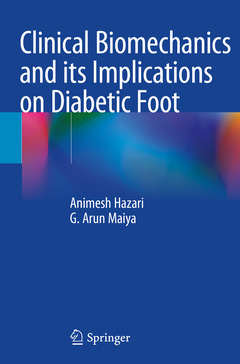Description
Clinical Biomechanics and its Implications on Diabetic Foot, 1st ed. 2020
Authors: Hazari Animesh, Maiya G. Arun
Language: English
Subject for Clinical Biomechanics and its Implications on Diabetic Foot:
Approximative price 52.74 €
In Print (Delivery period: 15 days).
Add to cartPublication date: 06-2021
176 p. · 15.5x23.5 cm · Paperback
Approximative price 52.74 €
In Print (Delivery period: 15 days).
Add to cartPublication date: 06-2020
Support: Print on demand
Description
/li>Contents
/li>Biography
/li>Comment
/li>
This book presents essential information on biomechanical features of the diabetic foot, which could help to minimize the risk of future diabetic foot problems.
India has recently been classified as the ?diabetic capital? of the world. Type 2 diabetes mellitus has become a serious concern for Indian society, where the prevalence rate is increasing exponentially. Similarly, the comorbidities and foot complications of type 2 diabetes mellitus are worsening day by day. Of all complications, diabetes peripheral neuropathy is the most common, and leads to foot deformities, pain, altered sensation, loss of foot arch, etc. The ultimate fate can even be gangrene and amputation. Accordingly, foot complications of diabetes represent a pressing medical issue.
Sharing insights into diabetic foot syndrome, its causative factors, prevention and management, this book offers a valuable resource for medical and paramedical students, researchers, podiatrists, surgeons, and physicians alike.
Introduction and understanding the diabetic foot syndrome.- Epidemiology and current status of diabetes mellitus and diabetic foot.- Pathomechanics of diabetic foot.- Patient’s perspective on diabetic foot.- Clinician’s perspective on diabetic foot.- Diabetic foot complications: Foot deformities, foot ulcers, peripheral vascular disease, claudication and amputation.- Diabetic foot ulcers-case report and case series.- Biomechanics of diabetic foot.- Role of plantar pressure in diabetic foot.- Biomechanical assessment and implications in of diabetic foot.- Important biomechanical features and findings in diabetic foot.- Interpretation and clinical decision making in diabetic foot.- Treatment and corrections of abnormal biomechanics in diabetic foot.- Awareness of general mass on diabetic foot and advancement in treatment techniques of diabetic foot.
Dr. Animesh Hazari (MS. Clinical Biomechanics, Ph.D.) graduated from Robert Gordon University, Scotland, UK and completed his Ph.D. on the Diabetic Foot at Manipal Academy of Higher Education, MAHE, Manipal, India. Currently, he is working as an Assistant Professor & Head of Department, LSPPS at Lovely Professional University, Jalandhar, Punjab, India. He is a well-known researcher with more than 20 publications in peer-reviewed, indexed national and international journals, and received Best Researcher awards for three consecutive years (2018-2020). He has also served as the Joint Secretary for Manipal University Research Forum to promote and organize quality research activities. His research interests include the diabetic foot, diabetes peripheral neuropathy, clinical biomechanics, sports biomechanics, and neuromuscular conditions.
Dr. G. Arun Maiya is presently working as the Dean at Manipal College of Health Professionals (MCHP), and as a Professor and Chief of Center for Diabetic Foot Care and Research, Manipal, India. He is a certified clinical podiatry specialist and accredited foot balance medical expert with the Finland Podiatry Medical Association, and a member of both the American Podiatry Medical Association and Indian Podiatry Association. He has published more than 120 scientific publications in both national and international journals. His main areas of expertise include the clinical evaluation of the diabetic foot, biomechanical assessment of the foot, and photobiomodulation.
Offers a broad discussion on the pathogenesis of diabetic foot problems
Covers all recent updates and advances in this field
Features high quality photographs and lucid illustrations
Includes a special chapter on patient’s perspective on diabetic foot




